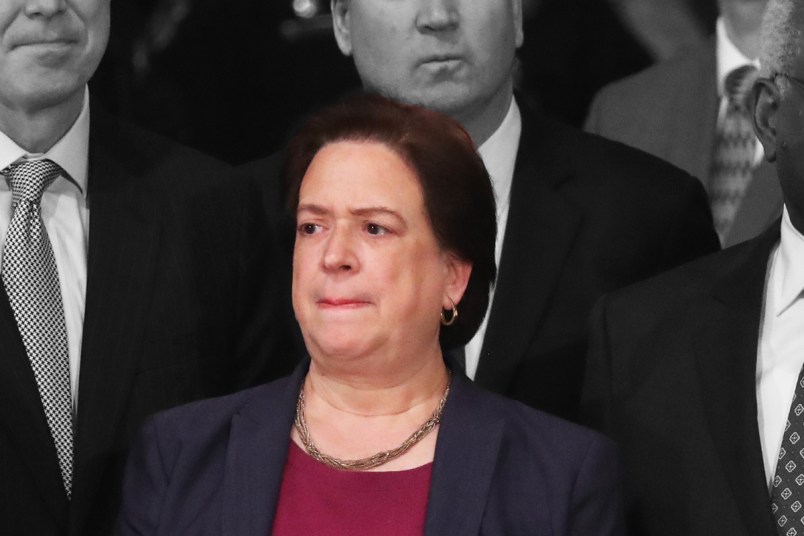Justice Elena Kagan, writing for the liberals in dissent, gets to the core of what the conservative majority’s dismantling of the Environmental Protection Agency’s power is really about: its animosity towards agency power in general, and desire to shift that power to itself.
The goal of the majority, she writes, is clear: “Prevent agencies from doing important work, even though that is what Congress directed. That anti-administrative-state stance shows up in the majority opinion, and it suffuses the concurrence.”
She sorts through the text of the guiding statutes painstakingly, showing that the EPA’s regulation of power plants by enforcing a shift to cleaner energy sources is plainly encapsulated in its written authority.
The proof that Congress entrusted the EPA with broad powers in this space is obvious, she argues. Congress added in limitations to other parts of its delegated authority to the agency. This sphere is well within what we’d expect the EPA to regulate.
“The current Court is textualist only when being so suits it,” she writes. “When that method would frustrate broader goals, special canons like the ‘major questions doctrine’ magically appear as get out-of-text-free cards.”
The major questions doctrine is a legal theory popular on the right, which states that Congress must explicitly delegate to agencies the ability to make rules on any given “major” questions, even if those questions appear to be covered by earlier laws, as is the case here.
Chief Justice John Roberts, writing for the majority, and Justice Neil Gosuch in his concurrence call this a “major questions” case, where the EPA’s theoretical efforts to force power plants to shift to cleaner energy sources — in straightforward ways like building new renewable plants, or more abstract ones like buying clean credits from across the grid — are simply too significant to be allowed under the Clean Air Act without Congress specifically authorizing the EPA to act.
Such a yardstick is foreign to the Court’s normal operations, Kagan argues, when the text of laws Congress has passed clearly allows the agency’s actions.
The majority, she says, “announces the arrival of the ‘major questions doctrine,’ which replaces normal text-in-context statutory interpretation with some tougher-to-satisfy set of rules.”
“The majority claims it is just following precedent, but that is not so,” she adds. “The Court has never even used the term ‘major questions doctrine’ before.”
Similarly to how the majority has used historical analysis in recent major cases on guns and abortion, now it substitutes in the idea of the major questions doctrine for how these types of cases have traditionally been decided. That such a strategy leaves the conservative justices with their preferred policy outcomes must be just a coincidence.
Kagan expands on why agency delegation makes sense: Congress is simply not suited to keep abreast of the latest climate technologies and developments, and lawmakers lack the expertise to craft regulations the way agency professionals do.
Congress also, in general, has proven unable or unwilling to pass major climate legislation, often because of Republican opposition and the Senate filibuster. So with an inoperable Congress and shackled agency, who is left holding all the power?
“In rewriting that text, the Court substitutes its own ideas about delegations for Congress’s,” Kagan writes. “And that means the Court substitutes its own ideas about policymaking for Congress’s. The Court will not allow the Clean Air Act to work as Congress instructed. The Court, rather than Congress, will decide how much regulation is too much.”
“The Court appoints itself—instead of Congress or the expert agency—the decision maker on climate policy,” she concludes. “I cannot think of many things more frightening.”







A rogue Supreme Court that is making rulings that are clearly politically based, with “because I said so” logic, that will result in unnecessary suffering and death of a real number Americans. Screw them.
What a disgrace to the Supreme Court legitimacy and for our country.
I’m getting the sense that this SCOTUS in their recent decisions, along with the work of the J6C, is setting the stage for a massive blowout victory for Democrats this November. Roberts and the other Federalists on the bench are making the case that this country simply cannot survive under Republican rule all too clear. We’ve seen their agenda, and it is not what we as Americans want.
I wanted to write that nobody would watch a sport in which the referees were so flagrantly biased. Then I thought of professional wrestling.
SCOTUS is presiding over the WWEffification of the country in more ways than one.
Let’s see if this makes sense. I interpret Justice Kagan’s description of the decision-making process as a conservative court junta that just makes shit up to serve its own prepared agenda.
“The Court appoints itself—instead of Congress or the expert agency—the decision maker on climate policy,” she concludes. “I cannot think of many things more frightening.”
I would include gerrymandering, deciding that it is not the voters who decide elections, gun safety, equal rights for women and minorities. There is so much this Republican and not conservative court is doing that it should scare the hell out of every American who believes in the Constitution.